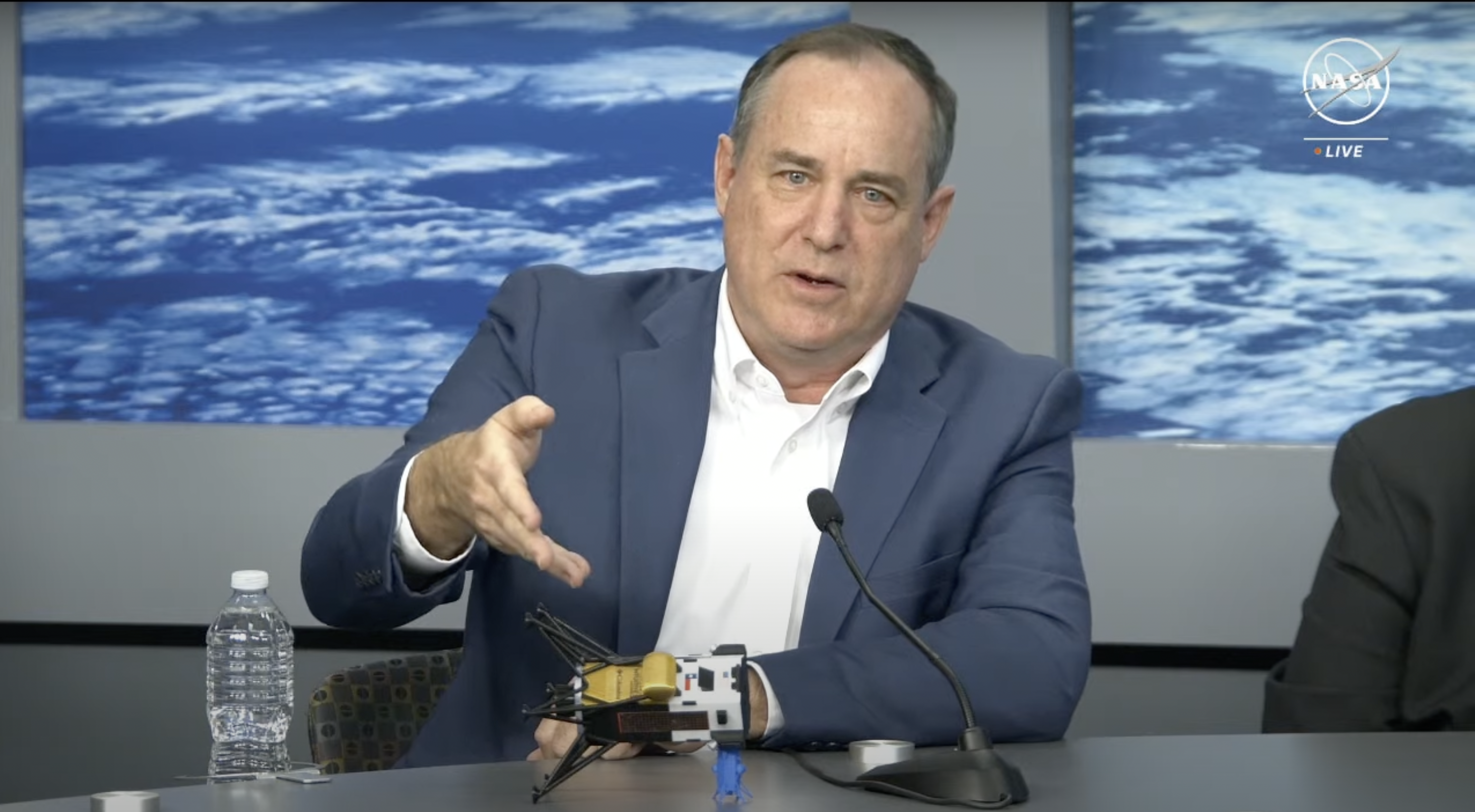🚀 直觉机器成功降落月球(侧身着陆!)🌕
昨天,'直觉机械'宇宙飞船在月球表面成功侧向着陆CEO史蒂夫·奥尔特穆斯在星期五的新闻发布会上确认,
“`html
Intuitive Machines avoided a disaster with quick thinking and a stroke of luck.

In an awe-inspiring feat of engineering and impressive luck, Intuitive Machines’ spacecraft, named Odysseus, successfully touched down on the surface of the moon. 🌕 CEO Steve Altemus announced during a press conference that although it wasn’t a perfect landing, it’s nothing short of a miracle that the spacecraft arrived in one piece.
To help us understand the challenging landing, Altemus used a small model of the lander to demonstrate the spacecraft’s descent based on the most recent telemetry data. “The vehicle is stable near or at our intended landing site,” Altemus revealed. “We’re downloading data from the buffers in the spacecraft and commanding the spacecraft.” 🛰️
Intuitive Machines confirmed that the touchdown occurred at 5:24 p.m. Central Time, making it the first company to put a privately-built spacecraft on the moon. 🎉 However, due to the shut-down of the onboard camera called EagleCam during the landing, many details regarding the lander’s health remained unknown. Engineers had to rely on other data sources to determine the spacecraft’s orientation after landing. 📸
A Thrilling Reconstruction 🚧
Even now, Intuitive Machines is piecing together the series of events that led to this historic landing. Initially, the company believed that Odysseus was upright upon touchdown. However, Altemus revealed that this assumption was based on “stale” telemetry data. From the currently available information, it appears that the spacecraft was indeed vertical but was moving horizontally and a bit too fast. As a result, one of its legs caught on something or broke, causing it to tilt over. 😱
The good news is that most of the onboard payloads are not on the downward-facing panel. The only payload on that side doesn’t require operation on the lunar surface. Intuitive Machines confirmed that the major subsystems, such as the solar arrays providing power and the onboard payloads, are functioning well. Phew! 😅
Quick Thinking and Big Luck 🍀
The success of this mission can be attributed to the quick thinking of Intuitive Machines’ mission controllers and, of course, a huge stroke of luck. The navigational challenges started after Odysseus performed a planned maneuver called lunar orbital insertion, which put it in an elliptical orbit around the moon. This fortuitous circumstance prompted mission controllers to use a navigational subsystem called “laser rangefinders” much earlier than planned. These lasers, which determine critical variables like altitude and horizontal velocity, were meant to be activated for the first time during the final descent phase.
However, to their dismay, the team discovered that the lasers were not functioning properly because they had forgotten to turn off a physical safety switch before launch. This mishap could have resulted in a catastrophic crash on the lunar surface, a fate suffered by many other landers. 🌚
Intuitive Machines considered several options to salvage the situation, ultimately deciding to utilize a NASA doppler lidar payload that was intended for technology demonstration. They instructed Odysseus to orbit the moon for an additional two-hour period to buy time for loading software patches and resetting the lander’s guidance, navigation, and control system.
The decision turned out to be a remarkable last-minute save. Prasun Desai, deputy associate administrator of NASA’s space technology mission directorate, stated that the successful execution onboard Odysseus has elevated the technology readiness level (TRL) of NASA’s doppler lidar from a hoped-for TRL 6 to an impressive TRL 9. It couldn’t have performed more flawlessly! 🌟
Future Developments and Implications 💡
Intuitive Machines’ successful lunar landing is not only a cause for celebration but also paves the way for future endeavors in commercial space exploration. With the rapid advancements in private space companies, we can expect more missions to the moon and beyond.
This achievement also highlights the importance of quick thinking, adaptability, and the ability to problem-solve in high-stakes situations. It serves as a testament to the resourcefulness and expertise of the Intuitive Machines team and their mission controllers. 🙌
“““html
随着我们深入商业太空探索时代,我们可以预见到更多突破和创新解决方案,克服我们在宇宙之旅中遇到的挑战。从这次任务中学到的经验无疑将为更成功的着陆和激动人心的科学发现奠定基础。🚀
问答:回答您的燃烧问题🔥
问:您能解释遥测数据是什么以及为什么对确定航天器状态至关重要吗?
答:遥测数据是指在任务期间由航天器收集和传输的信息。它包括有关各种系统的数据,如高度、速度、功率等。在奥德修斯的情况下,遥测数据提供了有关着陆器在着陆后取向的关键见解,因为在那段时间内,机载摄像头关闭了电源。工程师必须仅依赖这些数据来评估航天器的状态。
问:直观机器公司的任务在商业太空探索方面意味着什么?
答:直观机器公司成功着陆标志着商业太空探索的一个重要里程碑。它展示了由私人建造的航天器的能力,以及它们对科学事业的潜在贡献。随着更多公司加入探索太空的竞赛,我们可以预计私人和公共实体之间的竞争、创新和合作将增加。这次任务为未来登月和更远目标的任务打开了令人兴奋的可能性。
问:NASA的多普勒激光雷达技术如何促成着陆的成功?
答:多普勒激光雷达技术在任务的最后关头发挥了关键作用。它提供了确定高度和水平速度的关键数据,在着陆阶段这些是至关重要的变量。尽管最初是为技术演示目的而设计,但奥德修斯上成功执行的多普勒激光雷达推动了其技术成熟度水平达到新的高度。这一发展对依赖这一高级技术的未来任务大有裨益。
参考资料
- Intuitive Machines makes history by landing the first commercial spacecraft on the moon
- Intuitive Machines’ spacecraft engineers’ worst nightmare
- Happy Valentine’s Day, space fans! Intuitive Machines, SpaceX target moon mission lift-off on Feb. 14
现在轮到你了!在下方评论中分享您对直观机器公司卓越月球着陆的想法,并别忘了与朋友分享本文章。🌟🚀🌕
“`






